
- Index
- Brand
- Air Force (11)
- Alpha Industries (9)
- Army (18)
- Avirex (141)
- Bulova (9)
- Buzz Rickson's (11)
- Camillus (16)
- Elgin (26)
- Graflex (13)
- Hamilton (18)
- Imperial (10)
- Jordan (34)
- Nike (174)
- Polo Ralph Lauren (40)
- Swiss Army (41)
- Us Army (40)
- Victorinox (35)
- Vintage (8)
- Waltham (10)
- Willis & Geiger (13)
- Other (4198)
- Character
- Conflict
- Scale
- Theme
- Type
World War II Army Air Forces CBI M-1943 Field Jacket China, Burma, India WWII WW2
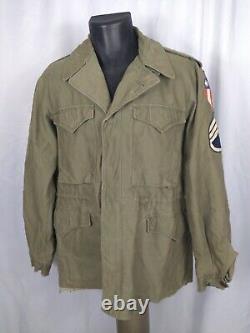
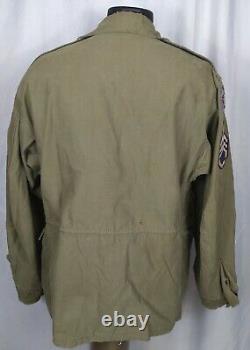
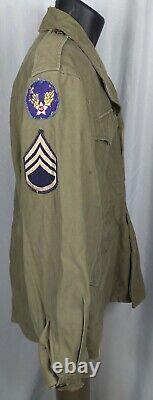
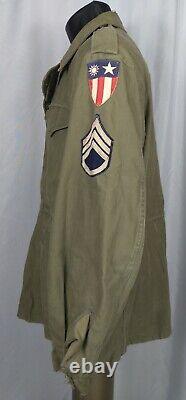
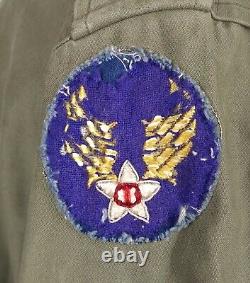

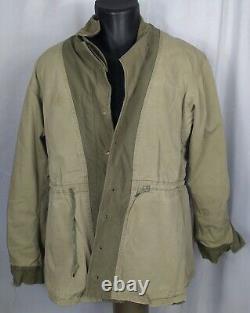
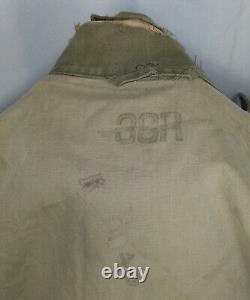

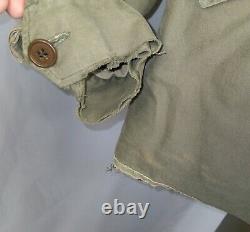
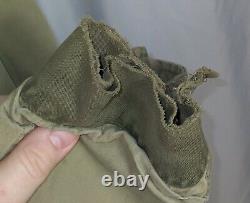
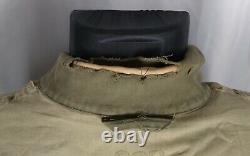


Very nice genuine World War II M-1943 field jacket that was worn by a member of the US Army Air Forces in the China, Burma, India Theater of Operations! This is a very field-worn example, but is complete with all of its original buttons and internal drawstring.
The left sleeve features a very nice theater-made CBI patch, which is machine sewn to the uniform. The left sleeve features a theater-made US Army Air Forces shoulder sleeve insignia - this one is rather delicate and very ragged and worn from period use. Both sleeves have Staff Sergeant chevrons that are machine-stitched to the uniform. As you can see, the cuffs and lower skirt of the jacket are very worn - it appears to had been frayed and trimmed.
The inside of the jacket is fine, with a laundry number visible, as well as a size stamp (38R). The laundry number appears to be K0043. The back portion of the collar has a 3 split in the material - as pictured. Overall, a fine jacket that despite its obvious signs of period use, still has a lot of display potential! The jacket remains in fair condition, showing signs of age, use, and wear. The exterior shows fading and soiling from period use. The cuffs and skirt edge appear to have been frayed and trimmed. The top portion of the back collar has a 3 split in the material from period use. The CBI patch is faded, but otherwise fine. The Army Air Force patch is very worn and delicate. The spec label is present, but washed out and mostly unreadable. Please see the pictures for more detail. Guaranteed 100% authentic in every respect for life.Be sure to see our other listings for more historical antiques and militaria. Be sure to follow our store as new inventory is added daily. China Burma India Theater (CBI) was the United States military designation during World War II for the China and Southeast Asian or India-Burma (IBT) theaters. Operational command of Allied forces including U.
Forces in the CBI was officially the responsibility of the Supreme Commanders for South East Asia or China. However, US forces in practice were usually overseen by General Joseph Stilwell, the Deputy Allied Commander in China; the term "CBI" was significant in logistical, material and personnel matters; it was and is commonly used within the US for these theaters.
And Chinese fighting forces in the CBI included the Chinese Expeditionary Force, the Flying Tigers, transport and bomber units flying the Hump, including the Tenth Air Force, the 1st Air Commando Group, the engineers who built the Ledo Road, the 5307th Composite Unit (Provisional), popularly known as "Merrill's Marauders", and the 5332d Brigade, Provisional or'Mars Task Force', which assumed the Marauders' mission. Army's M1943 uniform was a combat uniform manufactured in windproof cotton sateen cloth introduced in 1943 to replace a variety of other specialist uniforms and some inadequate garments, like the M1941 Field Jacket. It was used through the remainder of World War II and into the Korean War with modifications before being replaced by the OG-107 uniform beginning in 1952. The most recognizable part of the uniform is the standardized field jacket.
It was longer than the M-1941 jacket, coming down to the upper thighs, had a detachable hood, drawstring waist, two large breast pockets and two skirt pockets. It was colored olive drab shade no. 7 (OD7), a darker and greener shade than the previous field jacket. The uniform was designed to be warm in winter by use of separate liners for the jackets and trousers, both made of faux fur "pile".
The trouser pile liners were dropped from the final system in favor of the previous wool trousers. The jacket liner was a separate cotton-shell jacket with two slash pockets and button and loop fasteners, but it was rarely issued in practice during World War II as it was intended to be replaced by the M-1944 Eisenhower jacket, though that was made a garrison-only item before the Korean War.
The uniform was tested in Italy in 1943 by the 3rd Infantry Division but some GIs (including Bill Mauldin) claim that non-combatant officers and enlisted personnel would use their position in the rear to get the new uniform, delaying the ultimate field testing in Italy for some time longer. After D-Day, Paratroopers were issued complete M1943 uniforms, and infantry units began getting the uniform parts here and there.
